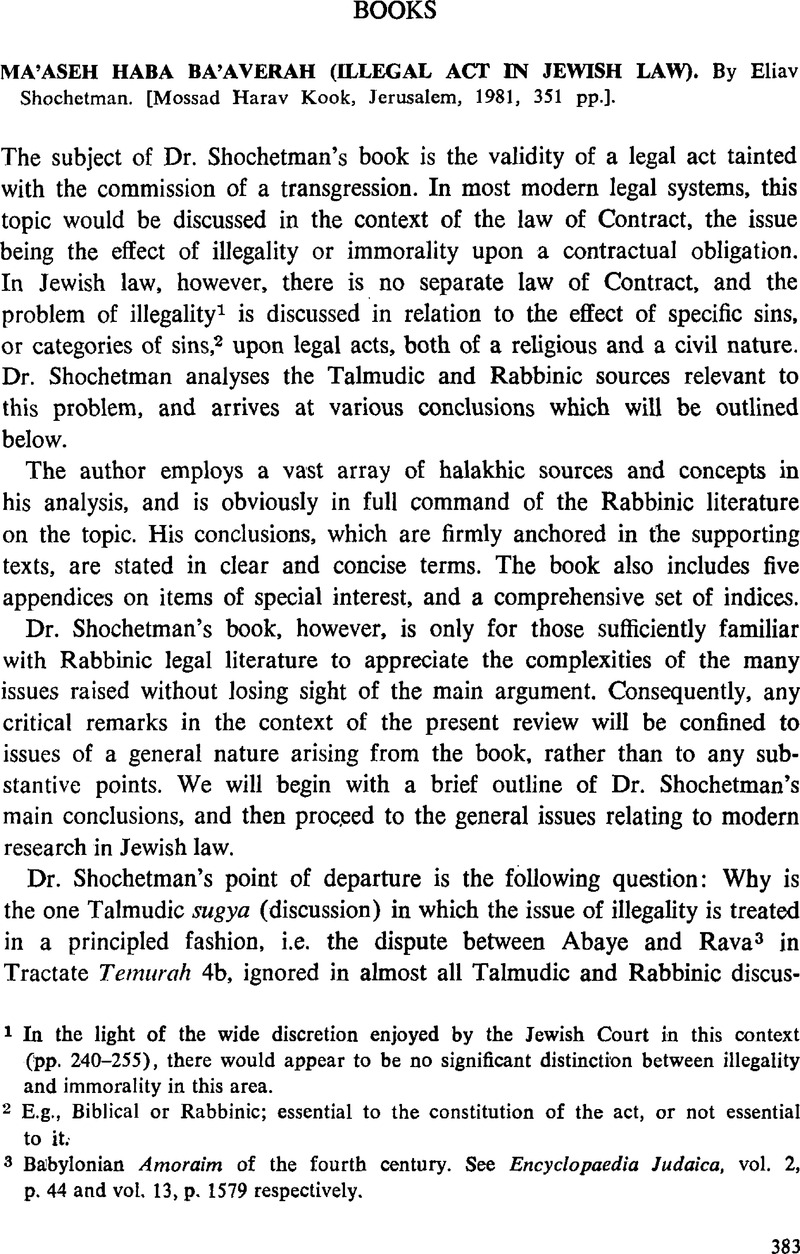No CrossRef data available.
Published online by Cambridge University Press: 12 February 2016

1 In the light of the wide discretion enjoyed by the Jewish Court in this context (pp. 240–255), there would appear to be no significant distinction between illegality and immorality in this area.
2 E.g., Biblical or Rabbinic; essential to the constitution of the act, or not essential to it.
3 Babylonian Amoraim of the fourth century. See Encyclopaedia Judaica, vol. 2, p. 44 and vol. 13, p. 1579 respectively.
4 Term used to designate later Rabbinic authorities (as opposed to the earlier Rishonim). See Encyclopaedia Judaica, vol. 2, p. 425.
5 This term designates Jewish Civil Law, as opposed to any other branch of the Halakhah. See Elon, M.. The Principles of Jewish Law (Jerusalem, 1975) 5.Google Scholar
6 See Zuri, Y., Mishpat Hatalmud (Warsaw, 1921) vol. 5, p. 23Google Scholar; Herzog, I., The Main Institutions of Jewish Law (London, 1967) vol. 2, pp. 135–139Google Scholar; Silberg, M., Kah Darko Shel Hatalmud (Jerusalem, 1964) 83 ffGoogle Scholar, and Warhaftig, S., Dinei Hozim Bamishpat Ha'ivri (Jerusalem, 1974) 184 ff.Google Scholar
7 For some of the wider, if somewhat extreme, ramifications of this issue, e.g., in relation to the Shabbatcan movement, see Scholem, G., Mehkarim Um'korot Letoldot Hashabtaut (Jerusalem, 1974) 9–67Google Scholar, and note Kurzweil, B., B'ma'avak Al Erkei Hayahadut (Tel Aviv, 1969) 126–130.Google Scholar
8 R. Avraham Karelitz (1878–1953). See Encyclopaedia Judaica, vol. 10, 787–788 and bibliography.
9 Kovetz Iggrot 1, 59: 2, 37. See also Yehuda, Z., “Hazon Ish on Textual Criticism and Halakhah”, (1980) 18 Tradition 172Google Scholar and S. Leiman, “Hazon Ish on Textual Criticism and Halakhah: A Rejoinder”, (1981) 19 ib. 301.
10 See Jackson, B.S. (ed.) Modern Research in Jewish Law (Leiden, 1980)Google Scholar for a collection of contemporary views on the question of research methodology. Note the editor's summary in which he pinpoints the main theoretical issues involved in the current debate on methodology in Jewish law research, and his suggestion that a new theoretical model based on modern theories of structuralism be adopted in this field. See most recently Shrieber, A., “A Suggested Approach to the Study of Jewish Law”, (1978–1980) 9 Dinei Israel 7.Google Scholar
11 27 L.S.I. 117.
12 See Friedman, D., “On the Interpretation of Modern Israeli Legislation” (1977) 5 Iyunei Mishpat 618Google Scholar and the remarks of Elon J. in Howard v. Miarah (1978) (II) 35 P.D. 505.
13 The Israeli court adverted to this problem in Kitan v. Weiss (1977) (II) 33 P.D. 785 in which the question of applying the “extra-legal” jurisdiction of the Jewish court in a secular framework was raised.
14 See M. Elon, supra n. 5 at 7 and 252–253, and in B. S. Jackson, supra n. 10 at 67–71; cf. I. Englard, Ibid. at 22–26.